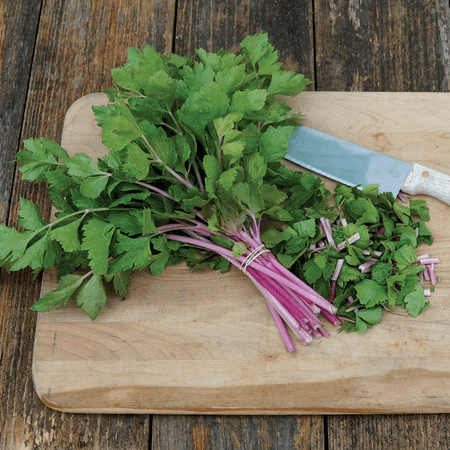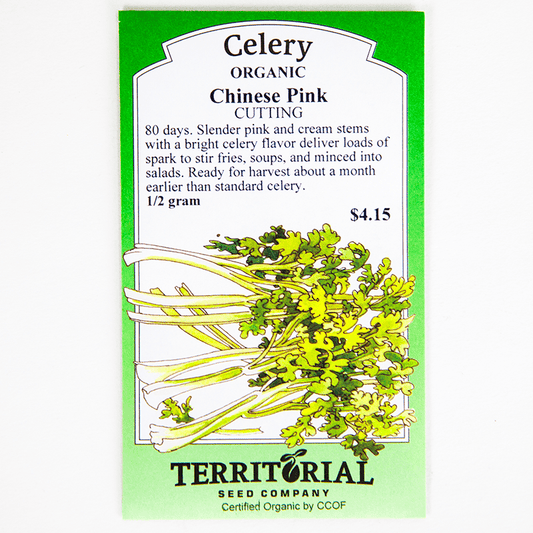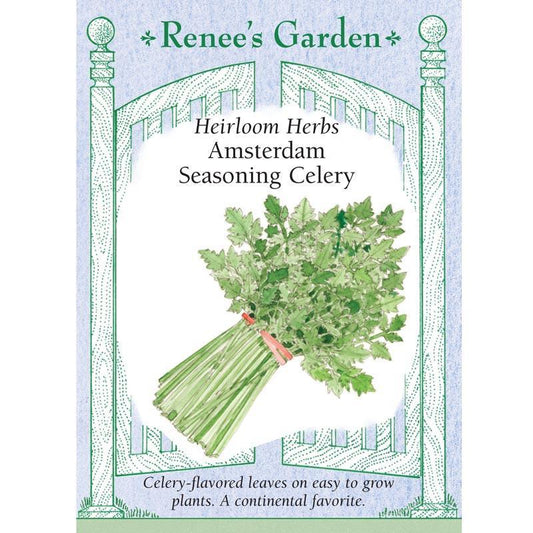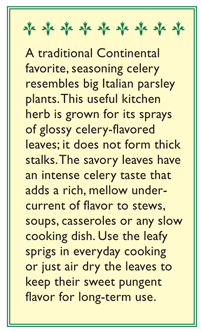Celery and celeriac are more difficult, but very versatile vegetables to grow in your home garden. Enjoy celery stalks fresh as a nutritious snack filled with peanut butter, chop celery or celeriac and cook it in a stir fry, celery juice is delicious to drink with breakfast, use the leaves as a seasoning, and both celery and celeriac make a great addition to your winter soup.
If you're wondering when, exactly, is a good time to plant your celery and celeriac seeds, enter your last frost date (for spring planting) and first frost date (for fall planting) into our Seed Planting Calculator. It will calculate the best dates to direct seed or start seeds indoors.
You can also calculate when to plant your seeds by using the sowing information on the back of the seed pack and counting backwards from your last frost date on your calendar.
Celery Types

Celery (Pascal): Stalk celery or pascal is the most common variety grown. Stalk celery has long, crunchy stalks. 105 to 130 days to harvest. Examples are Tall Utah and Pink Plume.
Celeriac: Also called celery root, is an enlarged mild flavored root grown for consumption. 100–120 days to harvest. Celeriac prefers coastal conditions. In USDA zones 7 and above, can be planted in the summer for a winter to spring harvest.
Leaf Celery: Thin stalks; aromatic leaves and seed are usually harvested to use as seasoning. Examples are Cutting Celery and Amsterdam Seasoning Celery.
Golden and Self Blanching: Sweet flavorful white stalks with thin petioles; less fiber and shorter storage life than other varieties.
Growing Basics
Soil: Celery and celeriac require rich, fertile, loamy soil with plenty of organic matter that retains moisture. Try growing celery in some of our Peaceful Valley Organics Potting Soil; it is an excellent, organic all-around mix.
Air Temperatures: Celery and celeriac need full sun, but cooler temperatures around 70-75°F.
Days to Emergence: 1-3 weeks, depending on variety and conditions.
Seed Longevity: If properly stored, the seeds should be viable for up to 5 years.
Spacing: 10–12” apart.
Companion planting:
- Incompatibility – corn, potato, aster, pumpkins, cucumbers, squash
- Companions – beans, onions, cabbage, spinach, lettuce, peas, tomatoes
Water Requirements: Celery plants and celeriac plants require a heavy, consistent water supply to surface soil for shallow roots. Avoid water on leaves or stalks to prevent rot.
Fertilization: Supplement according to soil test results. Address amendments prior to transplanting into garden. Work amendment and organic matter into bed before planting. Celery is a heavy feeder, so feed at 2 week intervals with balanced fertilizer or compost tea.
Planting & Growing
Sowing: Both celery and celeriac are usually planted out in the garden as transplants. Start celery seeds and celeriac seeds indoors 10–12 weeks before your average last frost date. To reduce germination time, seed may be pre-soaked in warm water. Press seeds into a quality soilless mix (Quickroot) that is pre-dampened. Seeds need light for germination, so cover lightly with soilless mix. Cover with dome lid to maintain moisture. Place in a bright spot out of direct light and maintain at 70–75°F. Seeds can take up to 3 weeks to germinate. Use a fine mist to keep seeds moist.

Transplanting: Plant outdoors when temperatures are at least 50°F during the day and no lower than 40°F at night. Harden off by reducing water slightly and keeping outdoors a few days prior to transplanting into garden beds. Plants should have at least 4 mature leaves before transplanting.
Space rows about 2 feet apart and plants about 1 foot apart, closer for celeriac. Plant in full sun or part shade (during the hottest part of the day). Keep consistently moist by using drip irrigation (avoid overhead watering) and mulch to help control weeds and maintain moisture. Lack of moisture can lead to bitter fibrous stalks.
Plants respond to cold temperatures (below 50°F for more than 12 hours) by bolting and will not produce as expected. If springtime temperatures drop too low, use a floating row cover to protect.
Keep well weeded, as celery does not compete well. Hand pull or use mulches to keep weed free. Celery has a shallow root system and does not tolerate deep cultivation.
Celeriac: Mound up soil over roots’ shoulders as it grows. Use mulch to retain moisture and reduce weeds.
Celery: For a milder flavor, mound soil up around the base of the plant or wrap stalks about two weeks prior to harvest with shields, maintaining leaf exposure, to blanch (use waxed milk cartons or paper) or tie stalks with flexible string to reduce sprawl.
Harvesting
Celery: If left too long, celery will become pithy and stringy; when too hot, stalks will be tough. Harvesting young is safest and equally flavorful. Individual stalks can be removed from exterior or remove entire plant when it is about 3” in diameter or at stalks are at least 6” tall (measured from soil line to first leaf).
Celeriac: Cut the plant when the root is about 3–5” in diameter. Harvesting after a light frost will improve flavor by “sweetening” the root. Remove dirt and rootlets and leave about 1” of leaves. If stored properly, celeriac can last for 6–8 months. Store in the refrigerator or place in sand and store in a root cellar.
Common Pests & Diseases

Beet Armyworm: Circular or irregular holes in foliage or skeletonized leaves; egg clusters may be present in leaves with fuzzy appearance. Hand pick them off or use an organic insecticide labeled for beet armyworm.
Black Heart: young leaves in the center of the plant become discolored and eventually turns black and dies. Usually not noticed until later in the growing season. Due to calcium deficiency and/or water stress during development. Amend soil with calcium rich fertilizers and maintain soil moisture.
Flea Beetles: Visual symptoms are holes in leaves. Use a light floating row covers such as Agribon AG15 (must be applied before pests arrive), hand pick them off, beneficial insects or an organic insecticide labeled for flea beetles.
Pink Rot: Lesions near base of petioles become soft, brown and/or sunken. Bacteria enter through plant wounds. Avoid bacteria conducive conditions by planting in well draining areas, disinfect all equipment, and avoid wounding plant tissues. Treat with an organic fungicide labeled for pink rot.
Root knot nematodes: Galls on roots; yellowing and wilting plants. Solarize soil or use an organic insecticide labeled for root knot nematodes.
Slugs or Snails: Leaves small holes and usually a slime trail. Hand pick or use an organic pesticide labeled for slugs and snails.
Pest Control – IPM (Integrated Pest Management)
Integrated Pest Management (IPM) is an effective and environmentally sensitive approach to pest management that starts with the least invasive or impactful control methods and considers the use of chemical controls as the last step. For more information watch our Integrated Pest Management video.
Important to practice good cultural controls for pest management of celery. Cultural controls such as removing plants after harvest (to avoid leaving food for insects to continue to multiply on), practice crop rotation (i.e. do not plant crops in same family, in the same area for 3 years), use row covers such as Agribon AG15 (apply before insects arrive or to protect against birds when plants are young).
Common Questions
Why plants are more leaf than stalk? Temperature fluctuations during early growth periods or if planted too early - protect with fabric or cloches if sudden temperature drops are expected.
Why are my plants bolting? Temperatures below 50°F for a period of 12 hours or more can cause bolting. Do not plant too early or use floating row covers to protect plants from cold temperatures.
What is eating the leaves of the plants? Large holes with slime trails are usually signs of slugs or snails. Celery worm or beetles can also eat leaves but usually deform stalks somewhat as well. Hand pick or use appropriately labeled products.
Why are stalks beginning to twist and color is yellowing? Leafhoppers spread disease called Yellow Aster and plants should be removed. Keep garden free of weeds where hoppers can pick up disease.
Inner stalks and leaves die and turn brown or black in color? This is called Black Heart. It is caused by a calcium deficiency or inconsistent moisture. Maintain proper soil pH, moisture and feed with calcium rich fertilizers.
Definitions
Heirloom: Heirloom seeds come from open-pollinated plants that pass on similar characteristics and traits from the parent plant to the next generation plant. Heirloom vegetables are old-time varieties generally which have been in production since before WWII, and have been saved and handed down through multiple generations.
Hybrid: a cross between two or more unrelated plant varieties. The two different varieties are cross bred, resulting in a seed that carries one or more favorable traits (increased yield, uniformity, color, disease resistance.) Hybrid seeds are not GMO, as they are manually cross-bred, not genetically modified in a lab. Hybrid seed is often sterile or does not reproduce true to the parent plant. Therefore, never save the seed from hybrids.
Open Pollinated: generally refers to seeds that will “breed true”. When the plants of an open-pollinated variety self-pollinate, or are pollinated by another representative of the same variety, the resulting seeds will produce plants roughly identical to their parents. Genetic traits may differ only slightly due to variations created by local conditions.
GMO: Genetically Modified Organisms were genetically modified in a laboratory where DNA genes are extracted and mixed with other unrelated plants to improve characteristics. Saved seed will not always be viable and may be trademarked to prevent unauthorized use.





